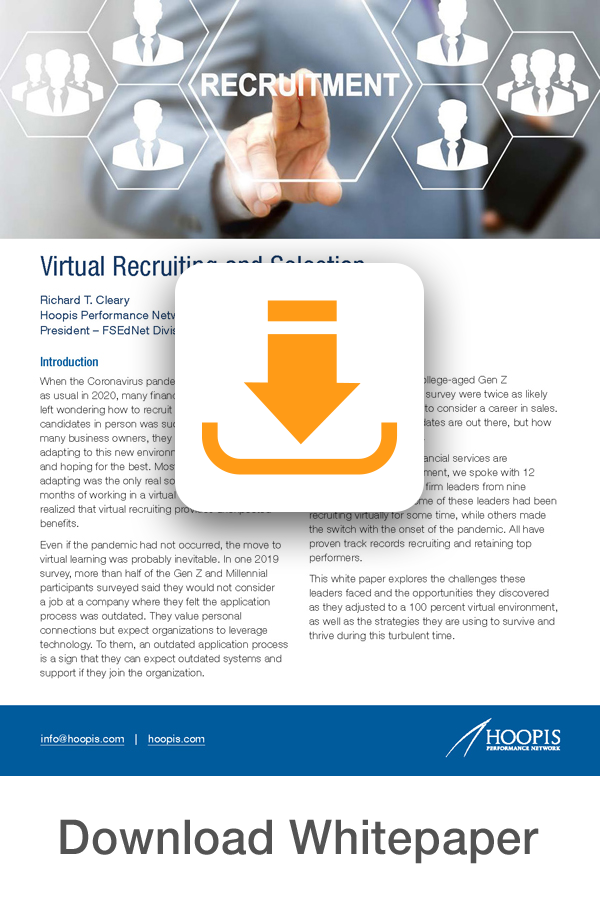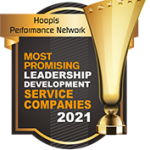Virtual Accountability

Introduction
When the Coronavirus pandemic disrupted business as usual in 2020, many financial services leaders were left wondering how to recruit in a world where meeting candidates in person was suddenly impossible. Like many business owners, they had a choice of either adapting to this new environment or waiting it out and hoping for the best.
Most realized early on that adapting was the only real solution. And after several months of working in a virtual world, many have also realized that virtual recruiting provides unexpected benefits.
Even if the pandemic had not occurred, the move to virtual learning was probably inevitable. In one 2019 survey, more than half of the Gen Z and Millennial participants surveyed said they would not consider a job at a company where they felt the application process was outdated. They value personal connections but expect organizations to leverage technology. To them, an outdated application process is a sign that they can expect outdated systems and support if they join the organization.
The good news is that college-aged Gen Z participants in that same survey were twice as likely as Gen X and Millennials to consider a career in sales. Strong, interested candidates are out there, but how you recruit them matters.
To see how leaders in financial services are faring in this new environment, we spoke with 12 experienced agency and firm leaders from nine different companies. Some of these leaders had been recruiting virtually for some time, while others made the switch with the onset of the pandemic. All have proven track records recruiting and retaining top performers.
This white paper explores the challenges these leaders faced and the opportunities they discovered as they adjusted to a 100 percent virtual environment, as well as the strategies they are using to survive and thrive during this turbulent time.
Key Takeaways for Leaders
- Be well-versed in using videoconference software, and learn to use features such as screen sharing, breakout rooms and the whiteboard.
- Now is the time to strengthen relationships with your centers of influence. Let them know you care about them personally and professionally.
- Schedule weekly or biweekly virtual career seminars and use your centers of influence and agents or advisors to drive attendance.
- Stick to your selection standards. Many people might be looking for work right now, but not all of them are a good fit for the profession or your firm.
- Hone your listening, observation and questioning skills for conducting virtual interviews, and use other steps in the process to provide a complete picture of candidates’ ability to perform and fit with your culture.
Virtual Platforms
Leaders who participated in our research use a variety of videoconferencing tools, including Zoom, Microsoft Teams, Google Meets, Adobe Connect and Skype for Business. Using videoconferencing software to conduct meetings with candidates creates a more personal connection than a phone call and allows leaders to assess candidates they can’t meet in person.
Listening, questioning and observing become more important when on a videoconference because some of the nuances you might notice in person can be lost. Still, nearly every leader in our research said they can get a good sense of a candidate’s fit with the profession and with their culture through videoconferencing.
One leader leverages the platform as an added step in his selection process. He notes, “I can tell if someone got onto a call early and paid attention to lighting, the camera angle, things like that. All of those things are indicators to me of the caliber of the candidate.”
Because so many people are familiar with videoconferencing now, your recruiting and selection team must be well versed in using the platform. This is particularly true with Gen Z and Millennial recruits, who are looking for tech-savvy organizations.
Several of the leaders we spoke with use platform features such as the whiteboard and breakout rooms. One leader uses the whiteboard exclusively with no PowerPoint presentation. He feels this creates a more engaging and interactive presentation than “death by PowerPoint.” Another leader purchased stand-up desks for his team, so they project more energy as they interact with recruits than if they were sitting.
Many leaders have also started using virtual backgrounds. This can project a more professional image and conceals any clutter that you might not realize is behind you while on screen. Many virtual backgrounds are available for free online, and several companies have also created virtual backgrounds that feature their company logos.
As prevalent as videoconferencing technology is, though, leaders warn that you shouldn’t make assumptions. It’s still a good idea to check with candidates ahead of time and thoroughly explain the virtual recruiting process.
Recruiting Candidates Virtually
Many leaders in our research were already using social media to source candidates before the 2020 pandemic. For most, however, the process following that initial virtual contact was often in person. Today, that has changed — the entire process, from sourcing through selection, is virtual. One leader noted, “I’m bringing people on board that I have never actually met in person and may not meet for some time.”
Referrals
Whether virtual or in-person, referrals from financial professionals and centers of influence remain the leading source of candidates. Obtaining these referrals is not significantly different in a virtual process. Actually, it might be easier during this time when many people are working from home and are easier to reach.
It’s especially important to keep your centers of influence engaged right now. Some leaders have started holding weekly virtual meetings with their centers of influence to teach them about their culture and the type of candidate most likely to succeed. Leaders also suggest giving centers of influence talking points about the virtual recruiting process. As always, be sure to keep them informed on the progress of their referrals.
Don’t forget that your centers of influence might be experiencing hardships during these difficult times; their businesses might be closed, or they might be struggling with health issues within their families. Now is the time to show that you care about them, both personally and professionally. Whether you are meeting in person or through a videoconference, the Golden Rule applies — give help before you ask for help.
One leader offers a word of caution: adhere to your hiring standards. Many people have been displaced from their jobs during the pandemic. And as much as you and your centers of influence would like to help them, you must stick to your selection standards. Finding people who are the right fit for the profession and your culture is just as important as ever.
Social Media
LinkedIn is still the most-used social site for making connections. The ability to connect with people through groups and mutual connections allows recruiters to make warm-source introductions that are more likely to result in a hire. Many leaders are also using Facebook, Instagram and other social media sites to attract candidates to their agencies’ and firms’ cultures. As one field leader noted, “Everyone is at home right now, and they are all on social media.”
As with centers of influence, remember that, with candidates, it’s better to give than to receive. Leaders in the research stressed the importance of posting content that provides value on social media sites, not just asking for referrals and introductions or posting job openings. Use these sites to introduce people to your values and culture and to demonstrate thought leadership in your areas of expertise.
Career Seminars
Many leaders in our research indicated they are holding weekly or biweekly virtual career seminars to introduce candidates to the profession. They post the events on social media and provide talking points to their financial professionals and centers of influence to help draw candidates to the event.
During these virtual seminars, leaders talk about the benefits of the profession and share their personal stories. Many speak of the changes taking place in the industry and the opportunities that come with change, such as the need to grow the profession because of an aging field force and the need for more women and more ethnic diversity in the profession. They talk about the opportunities available and discuss why this is an excellent time to come into the profession. And they explain how they will help candidates build and grow their businesses.
Most leaders recommend that virtual meetings last no longer than 30 minutes and be as interactive as possible to keep candidates engaged. The only challenge leaders identified for these events is that much of the collateral they would normally hand out in an in-person meeting is not designed for a virtual event. Some scan and send material via email or post it to be downloaded; others have redesigned recruiting materials for their virtual process.
One field leader also noted, “We ask for feedback at every event—even our career seminars. It’s how we continue to improve and attract new people.”
Job Boards and Career Fairs
With so much consolidation in the industry, along with the disruption in business due to the pandemic, some field leaders and recruiters have started using targeted job boards such as wallstjobs.com or reaching out to wholesalers to connect with financial professionals who are actively seeking new careers.
Virtual career fairs are becoming more and more common as well. As colleges and universities adjust to the new virtual environment, they have begun hosting virtual career fairs for their students and alumni. Where that isn’t happening, some leaders have reached out to colleges and offered to host virtual job fairs for them.
Job sites such as flexjobs.com and indeed.com also regularly host job fairs. Other sites, such as jobfairsin. com, post listings of virtual job fairs throughout the United States.
Selecting Candidates Virtually
Selection processes differ across organizations, but all use some combination of the same elements: virtual interviews, job-sampling activities, behavioral assessments and a candidate review process.
Virtual Interviews
Agencies and firms are using a combination of one-on-one and group videoconferencing interviews during their selection process. Some prefer virtual interviews because they feel candidates are more relaxed when they are in their own environment, and leaders can get a glimpse of the real person. Another advantage of the videoconference is the option to record it. When this is an approved option, leaders and recruiters can focus on the conversation with candidates without having to take notes. And they can go back and review the video to capture details or identify items they want to follow up on after the meeting.
Most leaders haven’t changed their questions in the virtual interview process. However, they are paying more attention to body language and asking more follow-up questions to be sure they are getting a good feel for a candidate’s willingness and ability to do the job. They are also spending more time digging into candidates’ reasons for joining the profession.
Leaders who are experienced with virtual interviewing recommend taking advantage of videoconferencing features such as breakout rooms. For example, one team starts with a large-group meeting for all candidates and then separates them into smaller groups using breakout rooms, where candidates can have more in-depth conversations with different managers.
Pre-Recorded Interviews
Some agencies and firms are experimenting with prerecorded video interviews as an initial screening tool. This is especially useful in college recruiting because recruiters can reach out to more schools and more candidates than they can by on-campus, inperson recruiting.
Candidates are asked to submit prerecorded videos answering questions supplied by the recruiter. It’s helpful to provide candidates with a tip sheet on how to prepare for this type of interview. Candidates are usually more relaxed because they can prepare and record their answers at a time that’s best for them. And recruiters save time because they can review the videos on their own time as well.
There are talent acquisition companies, such as yello. co, that specialize in automated recruiting systems and offer comprehensive services for prerecorded videos. For a less expensive and simpler option, you can simply ask candidates to create a video and send it to you or post it on a secure site.
Job-Sampling Activities
Leaders are continuing to require candidates to complete fact finders and market surveys and to present business plans. The only drawback to doing these activities virtually is that often, the materials they use were not designed for a virtual process. This has been a minor inconvenience, though, and leaders have quickly adapted.
Just as before, leaders are using job-sampling activities to determine if candidates have a market and if they are willing to prospect. The leaders we spoke with also stressed that, in today’s environment, it is more important than ever to see if candidates can overcome challenges.
Several leaders require candidates to submit a written business plan. Some have candidates present their plans virtually; others have candidates email the plans to the leadership team. The main purpose of the plan is to help recruits get off to a fast start. Leaders also use these plans as an assessment tool. They look at the quality and effort that went into the plan as an indicator of the candidate’s work ethic and desire to succeed.
Behavioral Assessments
Many leaders were already using behavioral assessments in their selection processes; others have added them since the pandemic. One leader noted the importance of these assessments right now: “Since I’m not meeting with people in person, I’m depending on these tests to fill in the gaps. If they don’t pass the test, they’re out. No exceptions.”
Among the behaviors leaders look for are emotional intelligence, social intelligence, conversation skills and high energy.
Candidate Review Process
Recruiting teams typically meet weekly to review the past week’s candidates and prepare for the next week’s interviews. As part of the preparation process, one team discusses how they can customize presentations for individual candidates. Because the meeting is virtual, this more personalized approach is much easier to do.
Virtual Challenges
Virtual recruiting is not without its challenges. Several leaders noted that testing centers have been closed during the pandemic, which is preventing recruits from getting licensed. And, while it may be easier to connect with people when they are at home rather than in the office, that’s possible only if you have their personal contact information. Some candidates, particularly experienced professionals, are reluctant to commit without meeting the leadership team in person and seeing the office space. As locations begin to loosen shut-down requirements, some leaders are allowing high-potential candidates to visit the office, even when selected candidates will be working from home.
The greatest challenge for some leaders has been launching recruits. There appear to be two schools of thought within the financial services community.
Some leaders feel it is unfair to launch recruits at a time when building their client base is going to be difficult, especially when their onboarding and training will also be virtual. “This is a significant obstacle for new people,” one leader noted, “and it’s unfair to bring them on at this time.” Some leaders have put their internship programs on hold for the same reason. These leaders are focusing their energies on experienced financial professionals. They believe experienced people will get through the pandemic successfully because they already have a client base and are established in the business.
Other leaders feel this is the perfect time to bring on inexperienced people. “This is not the new normal for inexperienced recruits,” a leader who is actively recruiting new people said. “It’s simply their normal. They don’t know a different way. To them, it’s just how we do business. I don’t get the same resistance as I do with some of the experienced folks.”
Whichever “camp” leaders fall into, all agree that virtual recruiting is not going away. It might never replace inperson recruiting, but it will play an important role in the process moving forward.
Virtual Learning Is Here to Stay
Many of the leaders we spoke with talked about the benefits of working virtually — for themselves, their agents and advisors, their staff members and their clients. More than one leader remarked, “I’m never going back to doing everything in person.”
Several leaders mentioned that they are more efficient and getting more done using a virtual approach. They’re saving time by not driving to different locations and can fit more calls into each day. One leader said he has shaved five days from his recruiting cycle time by doing everything virtually.
Even though they are busier than ever, several leaders also mentioned having a better work–life balance with the move to virtual because it provides more flexibility in their scheduling. However, one leader did point out the challenges many female recruits are facing. With schools and daycare centers closed, many parents — women in particular — are trying to manage increased demands on their home and work lives. “It’s important to be sensitive to those challenges,” the leader said, “and let recruits know you will support them through the process.”
Leaders in our survey shared two important pieces of advice for virtual recruiting. The first is to have a process and follow it. Each step in the process becomes even more important when you aren’t meeting with people in person. The second is to embrace this new approach. Don’t be afraid of the technology, and don’t wait for things to go back to normal. This is the new normal.
When the Coronavirus pandemic occurred in 2020, some of the leaders we spoke with had already been recruiting virtually for years, some jumped right into virtual recruiting and others were a bit slower to accept it. But almost everyone agrees that the change has created unexpected opportunities for increased efficiency, productivity and growth.



